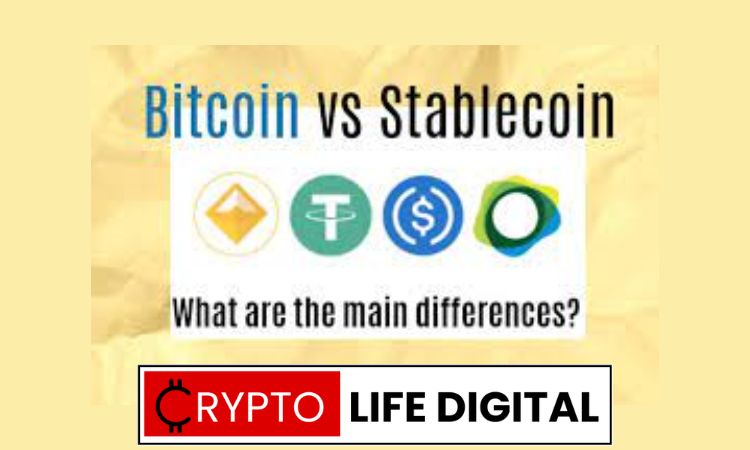Stablecoins vs Bitcoin: Are They The same?

The world of cryptocurrency has grown tremendously in the last decade, with Bitcoin being the most well-known and widely used cryptocurrency. However, in recent years, there has been a rise in the popularity of stablecoins, which have been hailed as a more stable alternative to Bitcoin. This article will compare stablecoins and Bitcoin, looking at their similarities, differences, and their use cases.
What are Stablecoins?
Stablecoins are a type of cryptocurrency that is designed to maintain a stable value relative to a particular asset or basket of assets. The most commonly used asset is the US dollar, although some stablecoins are pegged to other currencies such as the euro or yen. Some stablecoins are pegged to commodities such as gold.
Stablecoins are designed to be less volatile than other cryptocurrencies such as Bitcoin, which can experience large price swings. The stable value of a stablecoin makes it more suitable for use as a means of payment, as it can be used to purchase goods and services without the risk of losing value due to price volatility.
Read Also: Stablecoins: what are they and how do they work?
How do Stablecoins work?
Stablecoins are backed by a reserve of the asset or assets to which they are pegged. For example, a stablecoin pegged to the US dollar would be backed by a reserve of US dollars held in a bank account or other type of financial instrument. This reserve is designed to ensure that the stablecoin maintains its value relative to the pegged asset.
Stablecoins can be created in a variety of ways, including through the use of smart contracts and decentralized finance (DeFi) protocols. Some stablecoins are issued by centralized entities such as companies or financial institutions, while others are decentralized and operate on a peer-to-peer basis.
What is Bitcoin?
Bitcoin is a decentralized digital currency that was created in 2009 by an unknown person or group using the name Satoshi Nakamoto. Bitcoin operates on a decentralized network that allows users to send and receive payments without the need for a central authority, such as a bank or government.
Bitcoin uses a technology called blockchain to record all transactions on a public ledger. This ledger is maintained by a network of computers around the world, known as nodes. The blockchain ensures that transactions are secure, transparent, and irreversible.
Bitcoin has a limited supply of 21 million coins, which are created through a process known as mining. Mining involves solving complex mathematical problems to validate transactions and create new blocks in the blockchain. Miners are rewarded with newly created Bitcoins for their efforts.
Bitcoin vs. Stablecoins: Similarities
Bitcoin and stablecoins share several similarities. Firstly, they are both cryptocurrencies, meaning that they exist solely in digital form and are not backed by any physical asset such as gold or silver. Secondly, they both operate on decentralized networks that allow users to send and receive payments without the need for a central authority. This means that transactions can be made quickly and securely without the need for intermediaries such as banks or payment processors.
Bitcoin vs. Stablecoins: Differences
Despite their similarities, there are several key differences between Bitcoin and stablecoins. The most significant difference is their level of volatility. Bitcoin is notorious for its price volatility, which can fluctuate wildly in a short period. This makes Bitcoin unsuitable for use as a means of payment, as the value of the currency can change dramatically between the time of purchase and the time of payment.
Stablecoins, on the other hand, are designed to be less volatile than other cryptocurrencies such as Bitcoin. This makes them more suitable for use as a means of payment, as their value remains stable relative to the pegged asset. However, stablecoins are not immune to volatility, and their value can still fluctuate based on market conditions and the performance of the underlying asset.
Read Also: The Role Of Smart Contracts In Blockchain Technology
Another significant difference between Bitcoin and stablecoins is their level of decentralization. Bitcoin operates on a decentralized network that is maintained by a network of nodes around the world. This means that no single entity has control over the network, and transactions are processed in a trustless manner.
Stablecoins, on the other hand, can be either centralized or decentralized. Centralized stablecoins are issued by a centralized entity such as a company or financial institution and are backed by a reserve of the pegged asset held in a bank account or other financial instrument. This centralization means that the stablecoin is subject to the same risks as traditional fiat currencies, such as inflation, government regulation, and the risk of default by the issuer.
Decentralized stablecoins, on the other hand, operate on a decentralized network and use smart contracts and DeFi protocols to maintain their stability. These stablecoins are not backed by a centralized entity, but rather by a pool of collateral that is held in a decentralized network. This collateral is designed to ensure that the stablecoin maintains its value relative to the pegged asset.
Use Cases for Bitcoin
Bitcoin has several use cases, the most well-known of which is as a store of value. Many investors see Bitcoin as a digital gold, a hedge against inflation and a way to protect their wealth from market volatility. Bitcoin can also be used as a means of payment, although its volatility makes it unsuitable for everyday transactions. Finally, Bitcoin can be used as a speculative investment, with investors buying and selling Bitcoin based on market conditions and price trends.
Use Cases for Stablecoins
Stablecoins have several use cases, the most well-known of which is as a means of payment. The stable value of stablecoins makes them suitable for use as a means of payment, as users can make transactions without the risk of losing value due to price volatility. Stablecoins can also be used as a store of value, although they do not offer the same level of potential return as other cryptocurrencies such as Bitcoin. Finally, stablecoins can be used in DeFi protocols, where they can be used as collateral, traded on decentralized exchanges, and used to earn yield through lending and borrowing.
In conclusion, both Bitcoin and stablecoins have their advantages and disadvantages, and their use cases depend on the specific needs of the user. Bitcoin offers a high potential return on investment but is highly volatile and unsuitable for use as a means of payment. Stablecoins, on the other hand, offer stability but do not offer the same potential for return as Bitcoin. Ultimately, the choice between Bitcoin and stablecoins depends on the user’s risk tolerance, investment goals, and intended use case.
Follow us on Twitter, Facebook, Telegram, and Google News

Dr. Olajide Samuel juggles the demands of medical studies with a passion for cryptocurrency. A seasoned blogger, Olajide shares his vast global knowledge of the crypto space, offering insights to enthusiasts. Despite his busy schedule, his commitment to crypto remains strong, and he actively seeks ways to contribute to its future.







